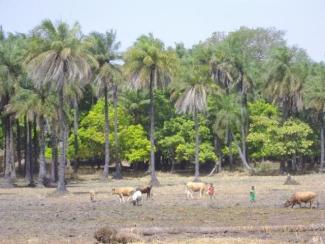Blog, USAID 60th anniversary
The natural region of southern Senegal has always been characterized by its lush vegetation, and among others, beautiful stands of palm groves. This is the case in Bambaly, in the administrative region of Sédhiou. Palm trees line the shallows and along the Casamance River. Threatened by abusive exploitation in the early 2000’s, the palm groves were the subject of management watched by the populations. The latter have initiated a management method called "thon" (which in the local language means the periodic deprivation of exploitation of the palm grove to allow it to mature. And, fun fact; it also means “tuna” in French).
The implementation of the local convention initiated by the Rural Council and the populations with the support of technical services and the USAID Wula Nafaa Program, has made it possible to safeguard forestry formation.
“The USAID Wula Nafaa Program has contributed a lot to better managing natural resources in the rural community,” said the President of the Rural Council.
"We are monitoring the harvest of nuts and pruning of palm leaves that are used to make brooms for women," said the President of the Environment Committee of the Rural Council.
It was in 2007 that the Rural Council initiated the Local convention for the safeguard of the palm grove and other tree species of the forest which allowed populations, particularly women, to have an income and to cope with poverty. About 10,000 liters of palm oil are extracted annually from the palm groves in the area.
The local convention is a tool for community management of natural resources. In Senegal, the application of this tool made it possible to save the palm grove

USAID Wulaa Nafa
